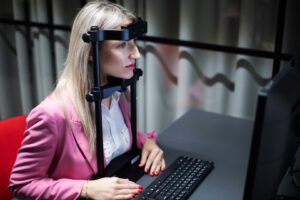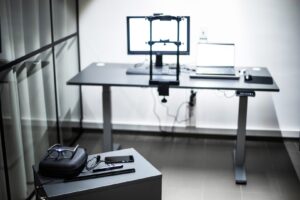In the recently opened KTU Eye-Tracking Lab, scientists are uncovering insights that can be used for a variety of purposes. “For example, eye-tracking technology allows the detection of fatigue while driving or can be used for testing and training purposes in the medical field,” says Ramunė Kasperė, professor at the KTU Faculty of Social Sciences, Arts and Humanities.
According to her, today, eye-tracking technology is widely used in a range of scientific fields. As it enables the assessment and analysis of a person’s gaze trajectory, eye gaze tracking is also used in games, marketing and human-computer interaction.
Use of advanced equipment
Researchers from the fields of education, neuroscience, communication, and philology are conducting research in the new KTU Eye-Tracking Lab.
The research tracks and records precise gaze movements and fixations when observing images or reading text. Speaking about the application of this technology in linguistic research, the KTU professor mentions the fields of reading, writing, translation and post-editing (machine translation editing).
“For example, tracking the eye gaze during translation and post-editing can reveal how attention is allocated and decisions are made. Gaze monitoring enables a detailed analysis of processes and provides insight into the cognitive world of the human mind,” says Prof Kasperė.
Eye-tracking to improve machine-translation
She says that machine-translation products that require additional editing to ensure their quality are rapidly entering the market. Eye gaze monitoring can reveal how post-editors interact with machine-translated content and help identify problematic areas in the text or complex language units.
However, there is a lack of multilingual data sets that would allow comparative studies. The new KTU Eye-Tracking Lab will collect data in the Lithuanian language.
“It will be used in research on human language processing from a psycholinguistic point of view, as well as to improve and evaluate computer language processing from a machine learning point of view,” says Prof Kasperė.





